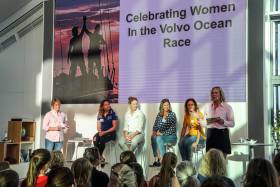Displaying items by tag: IWD 2018
Celebrating Inspirational Female Volvo Ocean Race Sailors On International Women's Day
#VOR - The Volvo Ocean Race celebrated 45 years of women in the race with a landmark event in Auckland on International Women’s Day, Thursday 8 March.
The event, organised by the Magenta Project, and supported by Volvo Ocean Race supplier GAC Pindar, saw iconic women from across the decades take to the stage to reflect on their experiences in Volvo Ocean Races of the past – and join the conversation on the future, in front of a packed crowd of over 200 attendees.
Three-time Volvo Ocean Race veteran Abby Ehler co-hosted the event, and was joined on stage by a panel consisting of Australian Leah Fanstone (US Challenge/Heineken 1993-94; EF Education 1997-98), Lisa McDonald (EF Education 1997-98; Skipper of Amer Sports Too, 2001-02), Dongfeng’s Carolijn Brouwer and Vestas 11th Hour Racing’s Hannah Diamond.
Over 20 female sailors — including Ireland’s own Annalise Murphy — have already competed in the race this edition, compared to just 200 in the four decades previously.
“It’s incredible to see the support for female participation in the event, from all corners of the sport,” said Ehler, who also competed on Amer Sports Too in 2001-02, and the all-female Team SCA in 2014-15.
“The Volvo Ocean Race has made great strides by introducing the mixed crew initiative prior to this edition, but it’s really key to keep the ball rolling in order to avoid a frustrating 12-year gap like myself and many others experienced after the 2001-02 edition.”
Ehler added: “How long will it take until there are as many women as men, with the right amount of experience and skills, competing at the top level of offshore sailing? We think the answer lies in this room, and those within the sailing industry.”





























































